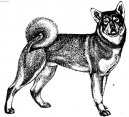Jamthund (Dog standard)
Jamthund was only recognised in 1946, although it is a very ancient type of dog that has been known since the north of sweden was populated.
FCI-Standard N° 42 / 05. 05. 2003 / GB
JÄMTHUND
(Jämthund)
TRANSLATION : Mrs. Renée Sporre-Willes.
ORIGIN : Sweden.
DATE OF PUBLICATION OF THE ORIGINAL VALID STANDARD : 25.03.2003.
UTILIZATION : Hunting dog.
CLASSIFICATION F.C.I. : Group 5 Spitz and primitive type. Section 2 Nordic Hunting Dogs. Working trial only for the nordic countries (Sweden, Norway, Finland).
BRIEF HISTORICAL SUMMARY : The Jämthund was only recognised in 1946, although it is a very ancient type of dog that has been known since the North of Sweden was populated. The reason for the late recognition is that the smaller Norwegian Elkhound and the Jämthund were judged as the same breed. This situation eventually turned out to be impossible. The Jämthund is mainly used for hunting elk but it has also been used for bear and lynx, particularly in earlier times. Hence it has to be very strong and of great endurance.
GENERAL APPEARANCE : Large, rectangular spitz, clean-cut, strong, substantial but also agile and with a good stature. BODY must not give the impression of being long, nor be too heavy.
BEHAVIOUR / TEMPERAMENT : Courageous and energetic but also stoically calm.
HEAD : Clean-cut and longish, proportionally broad between the ears.
CRANIAL REGION :
Skull : Slightly arched.
Stop : Well defined but not too deep.
FACIAL REGION :
Muzzle : Muzzle, measured from stop to nose, slightly shorter than from stop to occiput. Evenly tapering towards tip of nose. Muzzle must not be snipy, neither when viewed from above or from the side. Nasal bridge straight, broad and strong, nose wide.
Lips : Tight fitting.
Jaws/Teeth : Scissors bite.
Cheeks : Clean.
Eye : Slightly oval in shape, brown with keen but calm expression.
Ear : High set, perfectly erect, pointed and sensitive in use, slightly longer than width at base. Inside of ears well covered with HAIR.
NECK : Long, clean-cut, powerful with good reach.
BODY : Powerful and clean-cut, slightly longer than height at withers.
Topline : Straight and slightly sloping from withers to croup.
Loin : Broad and well developed.
Croup : Broad and only slightly sloping.
Chest : With good depth and well sprung ribs.
Underline and Belly : Belly slightly tucked up.
TAIL : Set high, of medium length and even thickness. Carried curled, but not tightly twisted over or close on the back. Dense COAT, but without fringe.
LIMBS
FOREQUARTERS :
Shoulder : Shoulder blade long, well laid back.
Elbow: Close to chest.
Forearm : Straight, clean-cut and with strong bone.
ForeFEET : Strong, somewhat oval, pointing straight forward with tightly knit toes.
HINDQUARTERS :
GENERAL APPEARANCE : Parallel when viewed from behind.
Stifle : Well angulated.
Hock joint : Well angulated.
Hind FEET : See front FEET.
GAIT / MOVEMENT : Powerful, free, with good reach. On the trot « single tracking ».
COAT
HAIR : TopCOAT rather close lying but not flat. UnderCOAT short, soft, light, preferably cream COLOURed. COAT smooth on HEAD and front of legs, longer on NECK, chest, TAIL and backside of legs and thighs.
COLOUR : Lighter and darker grey. Characteristic markings : light grey or cream COLOURed on sides of muzzle, cheeks, throat, chest, belly, legs and under the TAIL.
HEIGHT :
Height at withers : SIZE for dogs : 57-65 cm. Ideal 61 cm.
SIZE for bitches : 52-60 cm. Ideal 56 cm.
FAULTS : Any departure from the foregoing points should be considered a fault and the seriousness with which the fault should be regarded should be in exact proportion to its degree.
Yellow eyes.
Twisted TAIL.
Cream markings overlaid with black.
COAT too short.
Thin bone.
Short TAIL.
Straight TAIL.
SEVERE FAULTS :
Domed foreHEAD and bulging cheeks.
Snipy muzzle
Missing teeth, other than P1.
Square BODY shape.
Thin built.
Heavy, lymphatic built.
Flat FEET.
Unbroken, well defined white stripe on throat down to point of sternum, so called « tie ».
Insufficient rear angulation.
Thin, whip-like TAIL.
ELIMINATING FAULTS :
Aggressive or overly shy.
Height at withers other than stated in the standard.
Over-or undershot bite.
Hanging ears.
Lack of characteristic cream COLOURed markings.
Any dog clearly showing physical or behavioural abnormalities shall be disqualified.
N.B. : Male animals should have two apparently normal testicles fully descended into the scrotum.
Source: FCI >>> |
